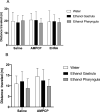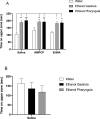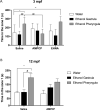Inhibition of ecto-5'-nucleotidase and adenosine deaminase is able to reverse long-term behavioural effects of early ethanol exposure in zebrafish (Danio rerio)
- PMID: 33082435
- PMCID: PMC7576130
- DOI: 10.1038/s41598-020-74832-0
Inhibition of ecto-5'-nucleotidase and adenosine deaminase is able to reverse long-term behavioural effects of early ethanol exposure in zebrafish (Danio rerio)
Abstract
The behavioural impacts of prenatal exposure to ethanol include a lower IQ, learning problems, anxiety and conduct disorders. Several components of the neurochemical network could contribute to the long-lasting effects of ethanol embryonic exposure. Adenosine is an important neuromodulator, that has been indicated to be affected by acute and chronic exposure to ethanol. Here, embryos of zebrafish exposed to 1% ethanol during the developmental stages of gastrula/segmentation or pharyngula exhibited anxiolytic effect, increased aggressiveness, and decreased social interaction. The exposure during pharyngula stage was able to affect all behavioural parameters analysed at 3 months-post fertilization (mpf), while the treatment during gastrula stage affected the anxiety and social interaction parameters. The aggressiveness was the only behavioural effect of early ethanol exposure that lasted to 12 mpf. The use of a specific inhibitor of adenosine production, the inhibitor of ecto-5'-nucleotidase (AMPCP/150 mg/kg), and the specific inhibitor of adenosine degradation, the inhibitor of adenosine deaminase, EHNA (100 mg/kg) did not affect the effects over anxiety. However, AMPCP at 3 mpf, but not EHNA, reversed aggressive parameters. AMPCP also recovered the social interaction parameter at 3 mpf in animals treated in both stages, while EHNA recovered this parameter just in those animals treated with ethanol during the gastrula stage. These results suggest that long-lasting behavioural effects of ethanol can be modulated by intervention on ecto-5'-nucleotidase and adenosine deaminase activities.
Conflict of interest statement
The authors declare no competing interests.
Figures





Similar articles
-
Neurochemical and Behavioral Consequences of Ethanol and/or Caffeine Exposure: Effects in Zebrafish and Rodents.Curr Neuropharmacol. 2022 Mar 4;20(3):560-578. doi: 10.2174/1570159X19666211111142027. Curr Neuropharmacol. 2022. PMID: 34766897 Free PMC article. Review.
-
Contributions of Zebrafish Studies to the Behavioural Consequences of Early Alcohol Exposure: A Systematic Review.Curr Neuropharmacol. 2022 Mar 4;20(3):579-593. doi: 10.2174/1570159X19666210428114317. Curr Neuropharmacol. 2022. PMID: 33913405 Free PMC article.
-
Persistent increase in ecto‑5'‑nucleotidase activity from encephala of adult zebrafish exposed to ethanol during early development.Neurotoxicol Teratol. 2018 Nov-Dec;70:60-66. doi: 10.1016/j.ntt.2018.10.004. Epub 2018 Oct 24. Neurotoxicol Teratol. 2018. PMID: 30366104
-
Contributions from extracellular sources of adenosine to the ethanol toxicity in zebrafish larvae.Reprod Toxicol. 2015 Jun;53:82-91. doi: 10.1016/j.reprotox.2015.04.001. Epub 2015 Apr 13. Reprod Toxicol. 2015. PMID: 25883026
-
Early exposure to ethanol is able to affect the memory of adult zebrafish: Possible role of adenosine.Neurotoxicology. 2018 Dec;69:17-22. doi: 10.1016/j.neuro.2018.08.012. Epub 2018 Aug 26. Neurotoxicology. 2018. PMID: 30157450
Cited by
-
CD73-Mediated Formation of Extracellular Adenosine Is Responsible for Adenosine A2A Receptor-Mediated Control of Fear Memory and Amygdala Plasticity.Int J Mol Sci. 2022 Oct 24;23(21):12826. doi: 10.3390/ijms232112826. Int J Mol Sci. 2022. PMID: 36361618 Free PMC article.
-
Neurochemical and Behavioral Consequences of Ethanol and/or Caffeine Exposure: Effects in Zebrafish and Rodents.Curr Neuropharmacol. 2022 Mar 4;20(3):560-578. doi: 10.2174/1570159X19666211111142027. Curr Neuropharmacol. 2022. PMID: 34766897 Free PMC article. Review.
-
Contributions of Zebrafish Studies to the Behavioural Consequences of Early Alcohol Exposure: A Systematic Review.Curr Neuropharmacol. 2022 Mar 4;20(3):579-593. doi: 10.2174/1570159X19666210428114317. Curr Neuropharmacol. 2022. PMID: 33913405 Free PMC article.
References
Publication types
MeSH terms
Substances
LinkOut - more resources
Full Text Sources
Research Materials
Miscellaneous

